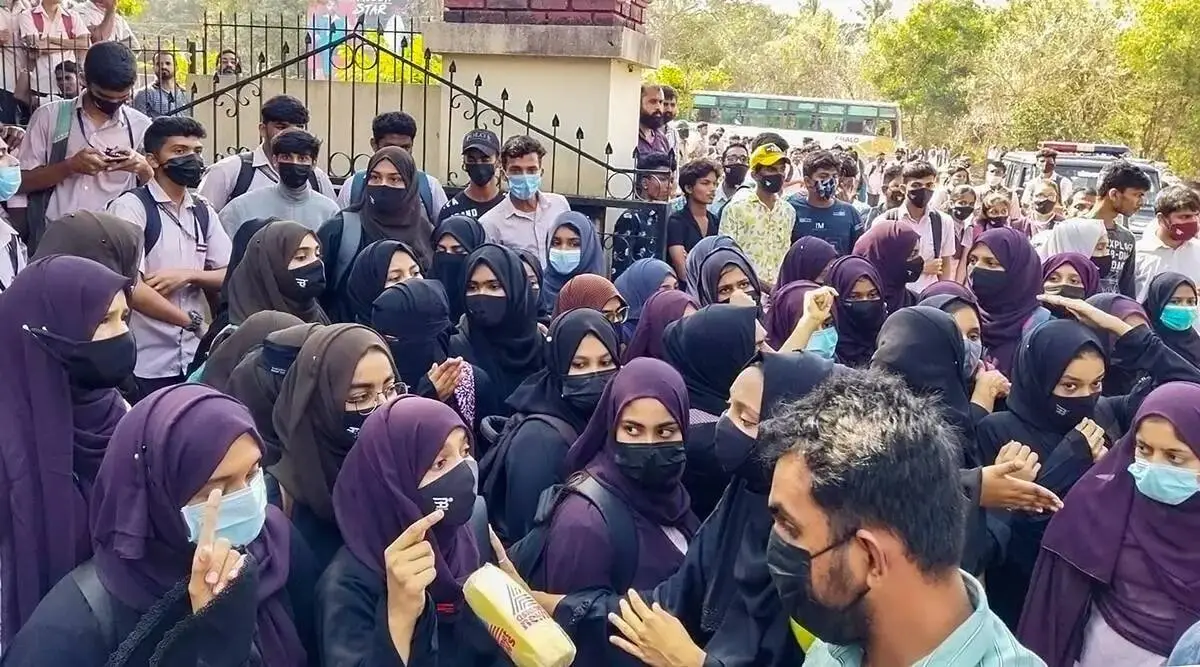Analysis: Is Hijab a Matter of Religion or a Matter of Choice?
Hijab, a headcovering worn by Muslim women, has been a topic of discussion recently. Whether it is the Hijab ban by the Karnataka High Court or the massive protests led by Iranian women, the practice of wearing the headscarf has been hitting the headlines quite regularly now. While the recent split verdict given by the Supreme Court of India in Aishat Shifa versus State of Karnataka and others raised many crucial questions regarding freedom of religion, it is also important to underline who is on the losing side and who will ultimately win the battle if Hijab is banned or allowed.
But, before moving ahead, let me first brief you about what Hijab is and where it came from.
What is Hijab?
You would be surprised to know that Hijab as a concept is not only a part of Islam but embraced by other religions such as Christianity and Judaism. Notably, the Islamic faith suggests different types of clothing for a woman to protect her modesty and integrity, and Hijab is one of them. It is a headscarf that covers the hair and neck. While there is no direct mention of the Hijab in the Quran (Islam's Holy Book), Chapter 33, Verse 59 - Al Azhab says, "O Prophet! Say to your wives, your daughters, and the women of the believers that: they should let down upon themselves their Jalabib." (33:59). Jalabib is the plural of Jilbab meaning a looser outer garment.
In simpler terms, one can say that Quran instructs Muslim women to protect their modesty through clothing. Some wear Hijab, some Khimar and some Burqa, but all have similar intentions of protecting their privacy from unrelated males either in public or at home.
If you Google about the history of the Hijab in Islam, you would find that veiling in Arabia was associated with high social status. The upper-class woman donned veiling both as an appropriate expression of Quranic ideals of being modest and as an announcement that her husband is rich enough to keep her idle. While high-class women donned it, the poor ones were slow to adopt it simply because it interfered with their work in the fields.
After Muslim countries started facing the wrath of westernisation during the 1960s and 70s, Iran brought the Hijab law, which made it compulsory for a Muslim woman to wear a headscarf before leaving her house. Soon, widespread demonstrations took place against the Hijab law, a similar scene that we are witnessing today in Iran.
When many Muslim women were protesting against the Hijab law, a movement known as Sahwah began in Saudi Arabia, where the female pioneers of the movement started donning Islamic dress to reunite and rededicate to the Islamic faith. So overall, what we could understand is even though many Muslim women see the practice of the Hijab as oppressive, many still see it as a way of adhering to the Islamic faith.
The brief timeline of Hijab also makes us understand the current scenario where on one hand, Iranian women are fighting against the Hijab law in Iran and burning their headscarves on streets, while on the other hand, Muslim girls in India are fighting against the Hijab ban in educational institutions. One cannot really point out who is right and who is wrong, or maybe, who is more Muslim and who is less.
Hijab - Against Secularism or Just Matter of Choice?
When we say India is a secular country, it means, in layman's language, that India as a nation has no religion, so it is not partial towards any particular religion. It conducts all human affairs based on political, economic, social and cultural aspects, while religion being purely a personal matter. The Supreme Court observed in its latest judgement that India has adopted the concept of secularism from the west but in a way which is conducive to its own history and experiences.
As we know, India is a diverse country where many religions are practised. To respect each religion, the Constitution of India has Article 25 (Part III), according to which every person living in India is entitled to freedom of conscience and the right to freely profess, practice and propagate any religion. However, since the right to religion is not absolute in nature, it is subject majorly to public order, morality and health. If we look at the Hijab controversy, one can contest from the moral point of view as wearing a Hijab cannot disturb the public order or affect someone's health as such.
Also read: Hijab Ban: Justices Hemant Gupta and Sudhanshu Dhulia Deliver Split Verdict; case Referred to CJI
It is important to note here that many Hindu practices, such as sati, widow remarriages, and dowry, were banned as they were considered as social evils. However, one cannot really say if wearing a Hijab can be compared as an equally immoral social practice. Wearing a Hijab can only disturb the social order morally only and only if a Muslim woman is forced to wear it before leaving her house without her choice. And that is what is being anticipated if the Hijab ban is removed. But still, it is just an assumption.
Another contentious point here is that we do many activities in our daily lives that are immorally wrong, but we still do them, right? Particularly it comes down to what is the role of a state here. Whether to give a warning and leave it to us or ban the activity altogether and force us to leave it?
For instance, when Muslim women were donning Hijab by their choice, they didn't find it oppressive. But only when they were forced to wear it did they find it unjust and detrimental to their equality. Well, as a woman, we have always been instructed by 'others' about what we should put on our bodies. This is not even limited to any specific religion; it is just a regular practice in many households even today.
For instance, a teacher was forced to resign for sharing a picture in swimwear on her Instagram page in Kolkata; well, how can an institution penalise an employee for their attire outside the campus? If you compare both cases, you'll find one thing in common - clothing. Who decides what is moral and what is immoral?
If wearing a Hijab is moral outside educational institutions, how does donning it inside the campus make it immoral? Whenever a social practice is banned, it is not prohibited in a specific area, especially when it is banned in the name of modernising society.
"The thing which was uppermost in mind was the education of girl child. It is a common knowledge that a girl child, primarily in rural and semi-rural areas, has a lot of difficulties; they have to do daily chores before she goes to school. There are other difficulties as well. Are we making her life any better?. That was also a question in my mind" - Justice Sudhanshu Dhulia.
While both Justices Hemant Gupta and Sudhanshu Dhulia gave many strong remarks in the Courtroom, justice Dhulia disagreed with Justice Gupta on a single point: 'What about the education of the girl child?'
While the Indian judiciary has the power to make laws, can it effectively change the mindset? For instance, child marriages in the country are banned under the Prohibition of Child Marriage Act, but India is still home to the largest number of child brides in the world (according to the United Nations Children's Fund)
Many researches have effectively shown that to change a mindset, you need education rather than stringent laws. While you can ignite a flame of change by passing a progressive law, you cannot keep it burning. Gay marriages are legal in India, but the practice is still considered a social stigma. If Hijab is banned and Muslim families stop sending their girls to educational institutions, the girl's education is ultimately being compromised. So Justice Dhulia's words may be hard to accept, but it effectively raises questions about the society we all are a part of.
Justice Hemant Gupta's point of maintaining homogeneity through uniforms might be a perspective, but Justice Sudhanshu Dhulia's celebrating diversity and imbibing values of tolerance and accommodation in children is a progressive view in itself. Considering the present scenario where India has been increasingly witnessing communal clashes, and controversial laws such as the Citizenship (Amendment) Act, a sense of respect and accommodation for different communities must be taught to the masses.
You can access the entire judgement of
Aishat Shifa versus State of Karnataka and others here: https://bit.ly/3Tk7tcb












